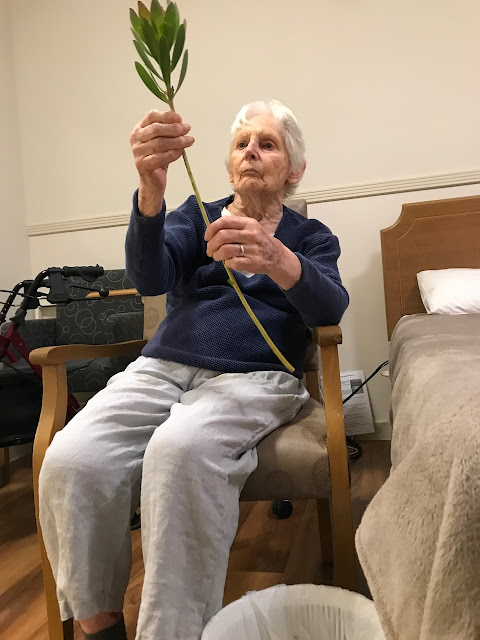We are really feeling the cold this week. This is because of the poorly-timed (winter) re-roofing of our house in Torquay. One of the necessary processes was the decommissioning of the gas heater in the living room. Fortunately, we have heating elsewhere in the house and we are able to stay warm.
Two of my Geelong students, Maree and Jo, sent me photographs recently of some ikebana arrangements they had made using Narcissus. They had taken the opportunity to make these arrangements using flowers from Jo's garden. Above is an ikebana Jo made using white Jonquils, in which the leaves have been arranged into a triangular design. The flowers form a point of focus at the top of the arrangement.
Maree's arrangement is also made with Jonquils from Jo's garden. She arranged the naturally-curving leaves to create an asymmetrical structure around the small mass of yellow flowers.
At the beginning of the week, I attended a workshop of the Victorian Branch of the Sogetsu school. The workshop was led by one of the teachers, Akemi Suzuki, who demonstrated techniques for using artificial gold leaf and gold powder on large leaves in an ikebana arrangement. She presented this topic as she had recently attended a workshop on the theme at the Sogetsu headquarters in Tokyo.
This is my arrangement from the workshop. I had cut two philodendron leaves, one of which had started to yellow on one side. I thought it looked particularly beautiful, especially after I had cleaned it with some white oil. I decided that the yellow colour would not look good with gold added to it. So I applied three small patches of gold leaf on the smaller lower leaf. Because the two leaves had significant visual strength, not much else was required to complete the ikebana. All I added was a small piece of driftwood placed at the top of the larger ot the two vessels.
More photographs from the workshop can be viewed via this link: Gold leaf and powder workshops.
After the workshop, I re-set the ikebana at home, altering the positioning of the vessels and bringing the driftwood to the front of the arrangement.
27th July 2025
.jpeg)





















